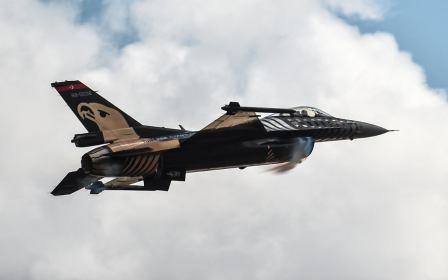Turkey accidentally reveals secretly developed short-range ballistic missile
Turkish officials who have for years worked covertly developing a short-range missile system woke up on Tuesday morning to one of their secrets being aired on national TV.
A video of a new missile called Tayfun, or Typhoon, during a test launch from the Black Sea town of Rize, was leaked and widely reported on Turkish and international media.
The new system was developed by Roketsan, a state-owned weapons manufacturer, and the test showed that it was capable of hitting targets at a distance of more than 500km in 456 seconds.
While people on Turkish social media were busy celebrating the existence of the missile, and asking questions on whether the Tayfun range could be enough to target Turkey’s neighbour Greece, Turkish officials were in a panic mode looking for the source of the leak.
New MEE newsletter: Jerusalem Dispatch
Sign up to get the latest insights and analysis on Israel-Palestine, alongside Turkey Unpacked and other MEE newsletters
Many in Turkey and the region believe Ankara planned to announce the Tayfun missile soon and the footage was part of the PR effort. Multiple people speaking to Middle East Eye said that the footage was leaked accidentally.
'In any case, if you look at it from the bright side, it has been a good advertisement for Tayfun'
- Turkish official
The leaker or leakers have still not been identified, one official said.
Speculation about their identity is rampant. Some people think it was a low-level PR company officer, a rookie that made an honest mistake.
Others suspect more sophisticated schemes since the quality of the footage was high.
“In any case, if you look at it from the bright side, it has been a good advertisement for Tayfun, '' one official told MEE. “We can sell it someday.”
Turkey’s missile capabilities
Since the footage was published, officials have been trying to understand how a secret test film ended up with the second-largest news agency in the country, the private Demirören News Agency (DHA).
DHA published the video along with details of the missile’s capabilities.
After the initial shock, officials informally asked media operators and TV channels to censor some of the details, such as the specific details on the missile’s range.

DHA complied and removed the initial story, replacing it with another one that omitted details about the missile and preserved only the footage.
Many other TV channels stopped airing the story.
Even though there is no international treaty that bans ballistic missile development programmes, Turkey has been cautious about revealing information about its weapons manufacturing capabilities.
Two other missiles were previously developed in the country, the Yildirim (Thunderbolt) and Bora (Storm), which have a 150km and 280km range respectively.
Out of an abundance of caution, Ankara does not reveal tests of rockets that have a 300km range or more, according to multiple sources.
Greek media
Turkish officials' attempt to suppress the story didn’t work, since the information was already out on social media, and many international observers were discussing it online.
The news also eventually made it to Greek media, which extensively reported on the development.
Speaking to Greek broadcaster ERT, retired General Frangoulis Fragos said that Turkish President Recep Tayyip Erdogan ordered the Turkish defence sector to design a missile that can travel 2,500km.
“It would give Turkey the ability to control the wider region and play the role of a regional power,” he said.
A retired Greek air force official, Konstantinos Iatridis, told the Greek newspaper Ta Nea that Tayfun needed to go through many tests to become operational.
“According to the experts involved in the construction of such weapons systems, it takes at least seven to eight years to become operationally ready,” he added.
Turkish media then circumvented the informal ban on reporting the story by quoting their Greek colleagues, with some, like the TV channel A Haber, ridiculing them for expressing fear against the Tayfun system.
On Thursday, the Turkish public news channel TRT World also began covering the test fire.
This article is available in French on Middle East Eye French edition.
Middle East Eye delivers independent and unrivalled coverage and analysis of the Middle East, North Africa and beyond. To learn more about republishing this content and the associated fees, please fill out this form. More about MEE can be found here.




